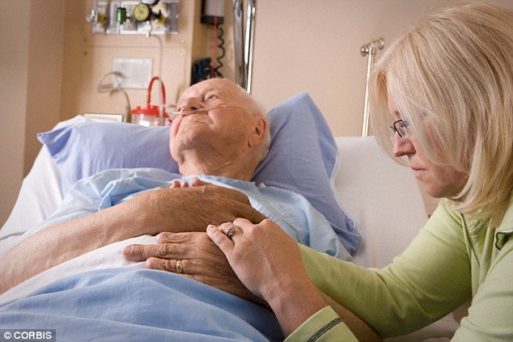Beginning this October, Medicare will begin penalizing nursing homes with higher than average hospital readmission rates, according to a June 19 report in MedPage Today. In an ongoing effort to curb preventable hospital readmissions, the agency will reward nursing homes that keep hospital readmission numbers low and decrease reimbursement to those whose residents wind up back in the hospital more often than they should.

Credit: hsc.unm.edu
The decision is the flip side of an existing policy that fines hospitals with higher than average readmission rates. That policy began in 2013, when federal regulators stepped in to try to stop the “revolving door” that shuttled far too many patients from hospital to nursing home and back to the hospital again. At that time, 12.8 percent of patients discharged from a hospital to a nursing home were readmitted with avoidable complications within 30 days. By 2016, that number was down to 10.8 percent. But, according to David Grabowski, a professor of health care policy at Harvard Medical School, that’s still too high. “We’re better, but we’re not well. There’s still a high rate of inappropriate readmissions,” he told MedPage Today.
Inappropriate readmissions are those that occur because of preventable complications, such as infections, medication errors, dehydration or falls.
Reimbursement Partly to Blame
The reasons behind the high hospital readmission rate from nursing homes are complex, but at least part of the blame falls on long-standing Medicare payment formulas, which classify patients according to a system known as Medicare-Severity Diagnosis Related Groups, or MS-DRGs. Under this system, Medicare reimburses hospitals a set dollar amount for patients in each MS-DRG based on the average anticipated length of stay. Thus, hospitals are incentivized to discharge patients as quickly as possible, since they will receive the same dollar amount no matter how long the patient is in their care. Consequently, patients are discharged to nursing homes far sicker and in need of a much higher level of care than many of these facilities can provide. The result: Frail elderly patients deteriorate quickly and are just as quickly readmitted to the hospital, usually in significantly worse shape than when they left. “And they never get quite back to normal,” said Dr. David Gifford, senior vice president of quality and regulatory affairs at the American Health Care Association, a nursing home trade group.
Also contributing to the “boomerang effect” is the fact that most nursing home patients are covered by Medicaid, which reimburses at a much lower rate than Medicare. But when a patient is admitted to the hospital for as little as three days, Medicare takes over reimbursement for the next 100 days. Additionally, in some states, Medicaid will pay the nursing home a “bed-hold” fee while a patient is hospitalized to ensure that they have a place to go when they are discharged.
Tragic Consequences
None of this is good for patients, who all too often suffer the consequences of communication lapses and fragmented care. Take the case of 61-year-old Sandra Snipes, who was admitted to the Richmond Pines Healthcare & Rehabilitation Center in Hamlet, North Carolina in 2011, while recovering from hip replacement surgery. Snipes’ hospital physician had ordered the staff to stop giving her twice daily injections of blood thinners. But for some reason, those orders were ignored when she was admitted to Richmond Pines. Later, nursing home staff accidentally dropped Snipes during a transfer, dislocating her recently replaced hip. Her surgical wound also became infected and, according to a statement by Snipes’ daughter, Laura Clark, infested with insects.

One in five patients discharged to a nursing home are readmitted to the hospital within 30 days
Credit: dailymail.com
Eleven days after being discharged to Richmond Pines, Snipes was readmitted to the hospital for the first time. She was subsequently discharged to a different nursing home, but was soon back in the hospital again. Eventually, due to recurrent infections, bleeding and other complications, her prosthetic hip had to be removed. She was never able to walk again.
Snipes’ husband cared for her at home until she died in 2015. According to Clark, her mother refused to go back into a nursing home. “She was terrified,” she said.
The family entered into a settlement with Richmond Pines for $1.4 million in 2017.
Advocates Fear the Worst
Unfortunately, penalizing nursing homes for sending patients back to the hospital has the potential to cause more harm than good, patient advocates warn. “We always worried that bad nursing homes are going to get the message, ‘Don’t send anyone to the hospital,’” said Tony Chicotel, an attorney at the San Francisco nonprofit California Advocates for Nursing Home Reform. This mindset already exists in some facilities, and is likely to get worse when readmission rates are tied to reimbursement.
Obviously, health policy experts will need to watch closely to see what happens when Medicare’s new policy goes into effect. Perhaps it may do some good. But it seems unlikely that the enormous challenges of coordinating care for an ever-increasing number of elderly will be resolved by policies that address reimbursement without also addressing the underlying issues that contribute to fragmented, poor quality care.

 Medicare to Tie Nursing Home Payments to Hospital Readmission Rates
Medicare to Tie Nursing Home Payments to Hospital Readmission Rates


 “As Tears Go By” by Marianne Faithfull
“As Tears Go By” by Marianne Faithfull

 Funeral Favors Offer Visitors a Tangible Memento
Funeral Favors Offer Visitors a Tangible Memento















